0 is the log odds of vomiting when age is equal to 0 (not very meaningful here) • β 1 is the increase/decrease in the log odds for a oneunit increase in age • eβ1 is the odds ratio comparing the increase/decrease in odds for those with a oneunit increase in age compared to the standard group;321 Log odds ratio First, the log odds of word w w in document i i is defined as logOi w = log fi w 1−fi w log O w i = log f w i 1 − f w i Logging the odds ratio provides a measure that is symmetric when comparing the usage of word w w across different documents Log odds ratio of word w w between document i i and j j isOdds ratios and logistic regression When a logistic regression is calculated, the regression coefficient (b1) is the estimated increase in the log odds of the outcome per unit increase in the value of the exposure In other words, the exponential function of the regression coefficient (e b1) is the odds ratio associated with a oneunit increase in the exposure

Statistical Analysis Sc504 Hs927 Spring Term Ppt Video Online Download
What is the log odds ratio
What is the log odds ratio-The prior log odds of the box containing a diamond are ln(1/19) = 294 The log of the likelihood ratio of a beep is ln((1/2)/(1/4)) = ln(2) = 069 The posterior log odds are 294 069 = 223 This corresponds to an odds ratio of e^223 = , and thus a probability of 0108/1108 = 0097 = 97% The correct answer is actually 95% Odds and Log Odds admin 0 Comments odd , log odd , odd and log odd In the previous tutorial , you understood about logistic regression and the best fit sigmoid curve
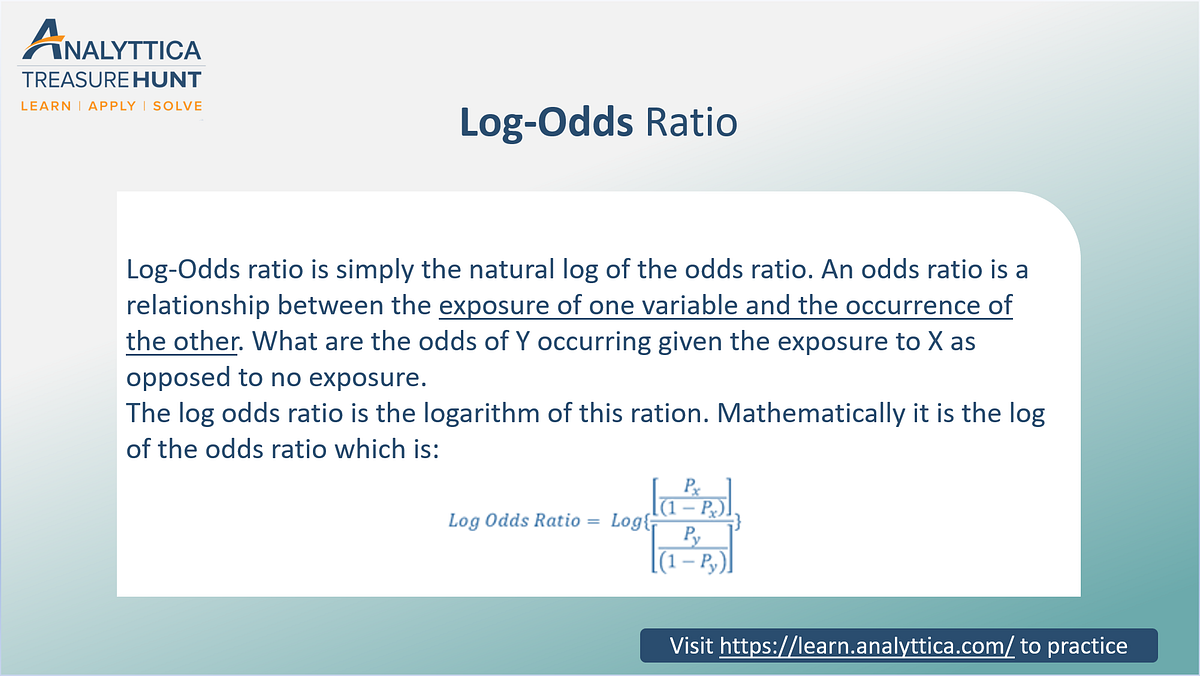



Log Odds Ratio Analytics Function Series By Analyttica Datalab Medium
Obtain the logodds for a given probability by taking the natural logarithm of the odds, eg,log(025)= or using theqlogisfunction on the probability value, eg,qlogis(02)=Relative risk (and odds ratio) can remain large • As the risk becomes common (> 10%), the OR greatly overestimates the RR • RR and RD are arguably more interpretable than OR, nevertheless the odds ratio is ubiquitous in Public Health and Medicine despite the tendency for people to interpret ORs as if they are RRs Odds ratio vs relative risk Odds ratios and relative risks are interpreted in much the same way and if and are much less than and then the odds ratio will be almost the same as the relative risk In some sense the relative risk is a more intuitive measure of effect size Note that the choice is only for prospective studies were the distinction
It would help to see your commands and output But, by default, margins is going to give you predicted probabilities, whereas the model coefficients talk about the effects of variables on the log odds of an event occurring Thank you Dr Williams for the respond Here is the commands I useOdds ratio is the likelihood that an event will occur in relation to the likelihood that an event will not occur, 1 event for and 5 events against In Gambling, the "odds" are a ratio of the likelihood of a certain outcome, related to the other outcomes I had to look this up, because I forgot this part of finite math, from 25 years ago Summary Our theoretical Odds Ratio is 0319 with a CI(0, 041), which is close to the true Odds ratio, 03This indicates if the undergraduate students are from the school in prestige 3 or 4, the chances of them getting in graduate school is 38% that of the students from prestige 1 or 2 undergraduate schools
The odds ratio (OR) is a measure of how strongly an event is associated with exposure The odds ratio is a ratio of two sets of odds the odds of the event occurring in an exposed group versus the odds of the event occurring in a nonexposed group Odds ratios commonly are used to report casecontrol studies The odds ratio helps identify how likely an exposure is to lead to a specificThis is not the same as the change in the (unlogged) odds ratio though the 2 are close when the coefficient is small 2 Your use of the term "likelihood" is quite confusing However,log odds do not provide an intuitively meaningful scale to interpret the change in the outcome variable Taking the exponent of the log odds allows interpretation of the coefficients in terms of Odds Ratios (OR) which are substantive to interpret;




Logit Model




Graphpad Prism 9 User Guide When To Use A Logarithmic Axis
e x p (β) = odds ratio = p 1 1 − p 1 p 2 1 − p 2 I guess what's not coming across is how β, not being a ratio of odds, converts to the odds ratio metric, when taken out of logarithmic space To provide a bit more, if this is the logistic regression equation for the constantThe more common the disease, the larger is the gap between odds ratio and relative risk In our example above, p wine and p no_wine were 0009 and 0012 respectively, so the odds ratio was a good approximation of the relative risk OR = 0752 and RR = 075 If the risks were 08 and 09, the odds ratio and relative risk will be 2 very different If the probability of an event occurring is Y, then the probability of the event not occurring is 1Y (Example If the probability of an event is 080 (80%), then the probability that the event will not occur is 1080 = 0, or % The odds of an event represent the ratio of the (probability that the event will occur) / (probability that the event will not occur)



Why Should We Use Log Of Odds In Logistics Regression And Not The Same In Linear Regression Quora




Log Odds Ratio Vs Tf Idf Vs Weighted Log Odds
The natural logarithm of the odds in favor of success at x (The log of odds is linearly related to x) Odds The odds in favor of success (the odds in favor of Y=1) at x Useful Statistics 1 Predicted Probability) p = => predicted probability of binary outcome Predicted probability of success for x = While odds are expressed in the ratio, the probability is either written in percentage form or decimal Odds usually ranges from zero to infinity, wherein zero defines impossibility of occurrence of an event, and infinity denotes the possibility of occurrence Conversely, probability lies between zero to oneIn statistics, the logit function or the logodds is the logarithm (=the inverse function to exponentiation) of the where p is probability 1 p is the probability of that event not happening odds p/ (1p) Ex Probability of success is 08 The




Iv Multiple Logistic Regression V Extend Simple Logistic




Statquest Odds And Log Odds Clearly Explained Youtube
The basic difference is that the odds ratio is a ratio of two odds (yep, it's that obvious) whereas the relative risk is a ratio of two probabilities (The relative risk is also called the risk ratio) Let's look at an example Relative Risk/Risk Ratio Suppose you have a school that wants to test out a new tutoring program For pediatric arrest, the risk of survival if intubated during arrest was 411/1135 (36%) vs 460/1135 (41%) if not intubated Let's convert to odds and calculate an OR Intubated 411/ = 411/724 = 057 odds Nonintubated 460/ = 460/675 = 068 oddsAn odds ratio of 112 means the odds of having eaten lettuce were 11 times higher among casepatients than controls Because the odds ratio is greater than 10, lettuce might be a risk factor for illness after the luncheon The magnitude of the odds ratio suggests a strong association




Statquest Odds Ratios And Log Odds Ratios Clearly Explained Youtube




Common Pitfalls In Statistical Analysis Logistic Regression Ranganathan P Pramesh C S Aggarwal R Perspect Clin Res
216 Odds ratios and logistic regression ln(OR)=ln(356) = −1032SEln(OR)= 1 26 1 318 1 134 1 584 = 95%CI for the ln(OR)=−1032±196×2253 = (−1474,−590)Taking the antilog, we get the 95% confidence interval for the odds ratio 95%CI for OR=(e−1474,e−590)=(229,554) As the investigation expands to include other covariates, three popular approachesEnglishwise, they are correct it is the odds and the odds are based on a ratio calculation It is not, however, the odds ratio that is talked about when results are reported The odds ratio when results are reported refers to the ratio of two odds or, if you prefer, the ratio of two odds ratios That is, let us write o(Xb) = exp(Xb) ## 1 ## TRUE The Rcode above demonstrates that the exponetiated beta coefficient of a logistic regression is the same as the odds ratio and thus can be interpreted as the change of the odds ratio when we increase the predictor variable x x by one unit In this example the odds ratio is 268




How To Show Odds Ratio Instead Of Log Odds In Bplot From Lrm Model Rms Package Stack Overflow




R Calculate And Interpret Odds Ratio In Logistic Regression Stack Overflow
The odds aren't as odd as you might think, and the log of the odds is even simpler! 1 Log Odds Ratio Log odds ratio is a statistical tool to find out the probability of happening one event out of 2 events In our case, its finding out which words are more or less likely to come from each book Here n is number of times that word is used by each scientist and total is total words by each one of themSwitching the rows or columns inverts the odds ratio For example, the odds ratio for no cough given a history of bronchitis = (247/26)/(1002/44) = 0417 = 1/2397 This is the reciprocal of the OR for cough There are only two possible odds ratios, as switching both rows and columns gives us odds ratio we started with On the log scale, these




What And Why Of Log Odds What Are Log Odds And Why Are They By Piyush Agarwal Towards Data Science



17 Logistic Regression
The odds ratio for your coefficient is the increase in odds above this value of the intercept when you add one whole x value (ie x=1;Then the natural logarithm of this ratio (or the Log Odds) is evaluated (the Log Odds values are also shown on the Log Odds Table under Log Odds) Note, however, that there might be a problem in the evaluation of the log odds if there are bins with zero positive cases But this problem can be easily fixed with standard techniques The odds ratio is the ratio of two odds ODDS RATIO Odds Ratio = Odds of Event A / Odds of Event B For example, we could calculate the odds ratio between picking a red ball and a green ball The probability of picking a red ball is 4/5 = 08 The odds of picking a red ball are (08) / 1(08) = 08 / 02 = 4 The odds ratio for picking a red




Log Odds Interpretation Of Logistic Regression Youtube
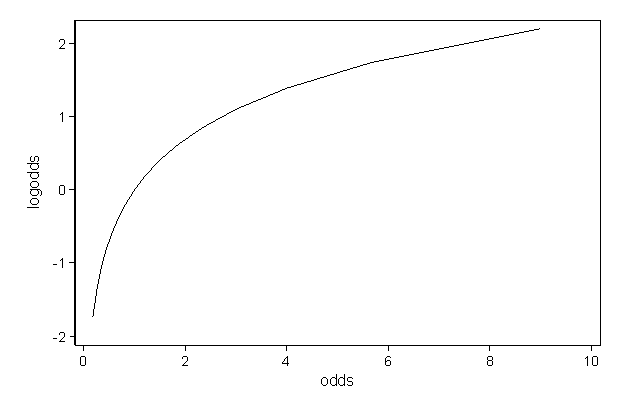



Faq How Do I Interpret Odds Ratios In Logistic Regression
Odds Ratios and Log(Odds Ratios) are like RSquared they describe a relationship between two things And just like RSquared, you need to determine if this Crude Odds Ratio – the odds ratio calculated using just the odds of an outcome in the intervention arm divided by the odds of an outcome in the control arm Adjusted Odds Ratio – is the crude odds ratio produced by a regression model which has been modified (adjusted) to take into account other data in the model that could be for instance a Odds of winning = 4/6 = log(Odds of winning) = log() = 0176 Odds of losing = 6/4 = 15 log(Odds of losing) = log(15) = 0176 Figure6 log(odds) on a Number Line Look at that, it looks so symmetrical and a fair comparison scale now



Confluence Mobile Wiki Ucsf




Why Do So Many Practicing Data Scientists Not Understand Logistic Regression R Y X R
Log Odds Ratio log(θ) θ= 36 Log(θ) =36 θ= 05 Log(θ) =07 θ= 2 Log(θ) = 07 θ= 1 Log(θ) = 0 Odd Ratio Log Odds RatioCalculate the diabetes risk for 4 individuals using their genotype data using odds ratios vs likelihood ratios Note whether the two methods of risk estimation provide concordant or discordant results What is the effect size of the 26 SNPs examined in this analysis?We can easily transform log odds into odds ratios by exponentiating the coefficients (b coeffcient= 0477)




Natural Log Odds Ratio In Excel Top Tip Bio



Logit Wikipedia
One thought) Using the menarche data exp (coef (m)) (Intercept) Age e10 e00 We could interpret this as the odds of menarche occurring at age = 0 is Risk ratios, odds ratios, and hazard ratios are three ubiquitous statistical measures in clinical research, yet are often misused or misunderstood in their interpretation of a study's results A 01 paper looking at the use of odds ratios in obstetrics and gynecology research reported 26% of studies (N = 151) misinterpreted odds ratios as risk ratios , while a 12 paper 1 The logistic regression coefficient indicates how the LOG of the odds ratio changes with a 1unit change in the explanatory variable;




Volcano Plot Depicting Log Odds Ratios And P Values Of The Download Scientific Diagram




Odds Ratio The Odds Ratio Is Used To Find The By Analyttica Datalab Medium
Has been to change the Odds of the man having the disease by multiplying the Prior Odds by the Likelihood Ratio 765 Calculating Likelihood Ratios The Likelihood Ratio (LR) can be calculated directly by using a quantitative assessment of the evidence, ie calculating the alternative probabilities of a given outcome, P3) log(h(tX)) = log(h o(t)) 1ClinicB 2Dose 1 Log hazard ratio of dropout from the maintenance treatment program between patients in clinics B and A who take the same dosage of methadone 2 Log hazard ratio of dropout from the maintenance treatment program between two individuals who are at the same clinic and whose dosage differs by 1 mgThis StatQuest covers those subjects so that you can understand the stati




Logistic Regression Why Sigmoid Function



Plos One Statistical Learning For Turboshaft Helicopter Accidents Using Logistic Regression
The odds are 245/(1245) = 3245 and the log of the odds (logit) is log(3245) = In other words, the intercept from the model with no predictor variables is the estimated log odds of being in honors class for the whole population of interestThe odds ratio is used when one of two possible events or outcomes are measured, and there is a supposed causative factor The odds ratio is a versatile and robust statistic For example, it can calculate the odds of an event happening given a particular treatment intervention (1)




What And Why Of Log Odds What Are Log Odds And Why Are They By Piyush Agarwal Towards Data Science




Meta Analysis Of Odds Ratios Current Good Practices Abstract Europe Pmc




Odds Ratios Need To Be Graphed On Log Scales Andrew Wheeler




Interpreting Mlogit Coefficients In R Odds Ratios And Negative Coefficients Cross Validated




13 5 Odds Ratio Plot R For Health Data Science




Plotting Odds Ratio S And 95 Confidence Intervals Stack Overflow




Julia Silge New Post Introducing Tidylo An Rstats Package For Weighted Log Odds Ratios Using Tidy Data Principles Developed With Tschnoebelen And Demonstrated Here With Us Baby Names T Co Rmrgmau3pv
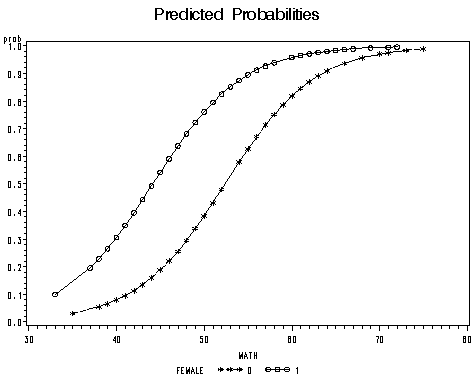



Proc Logistic And Logistic Regression Models



1




Mathfrak Michael Shapes Dude Betancourt Friendly Reminder That From A Math Perspective Probabilities In Logistic Regression Are Almost Exactly The Same As Velocities In Special Relativity If You Understand Log Odds
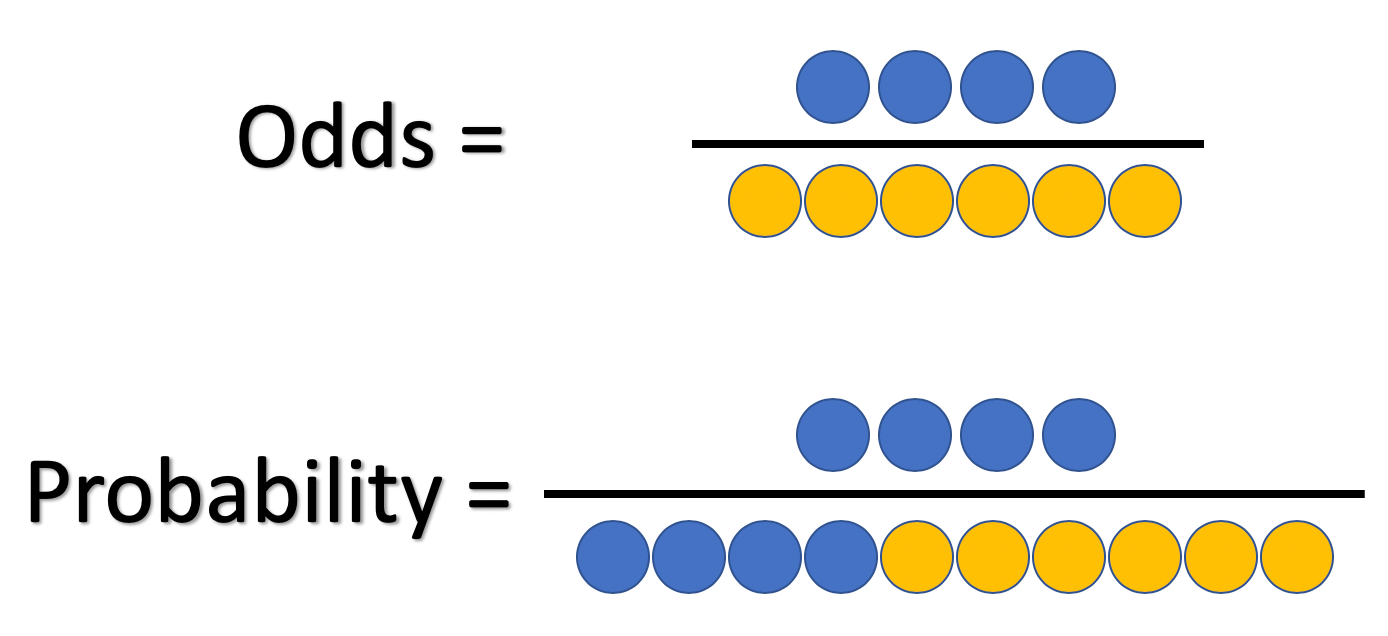



What And Why Of Log Odds What Are Log Odds And Why Are They By Piyush Agarwal Towards Data Science




Relative Risk Odds Ratios Youtube
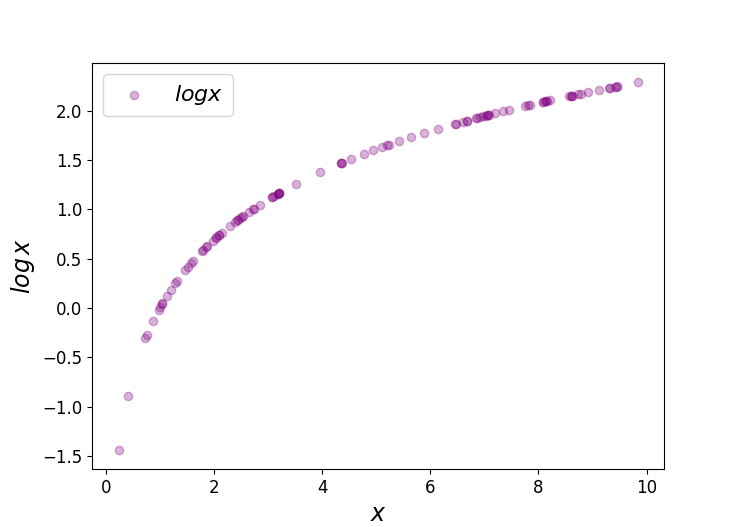



Logit Of Logistic Regression Understanding The Fundamentals By Saptashwa Bhattacharyya Towards Data Science




Logit Of Logistic Regression Understanding The Fundamentals By Saptashwa Bhattacharyya Towards Data Science




Plotting Odds Ratio Vs Continuous Variable In Stata Stack Overflow




Odds Ratios The Odd One Out Stats By Slough




What And Why Of Log Odds What Are Log Odds And Why Are They By Piyush Agarwal Towards Data Science




Re Re 999 999 Odds Ratio In Logistic Regressi Sas Support Communities




Forest Plot Wikipedia




Odds Log Odds And Odds Ratio Inblog
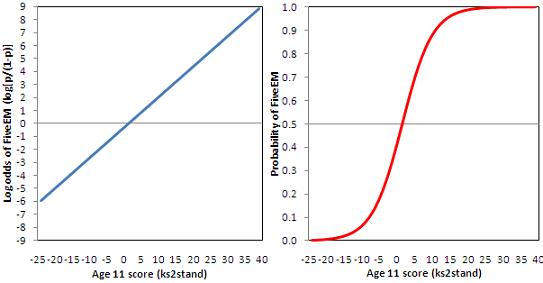



4 5 Interpreting Logistic Equations



Logistic Regression Theoretical Understanding By Payal Bhatia Medium




Relative Risk Vs Odds Ratio Extensive Video Youtube




How Do I Interpret Odds Ratios In Logistic Regression Spss Faq




Math Formula To Reproduce A Plot Comparing Relative Risk To Odds Ratios Cross Validated




Log Odds Ratio
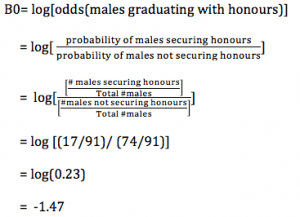



Logistic Regression A Concise Technical Overview Kdnuggets
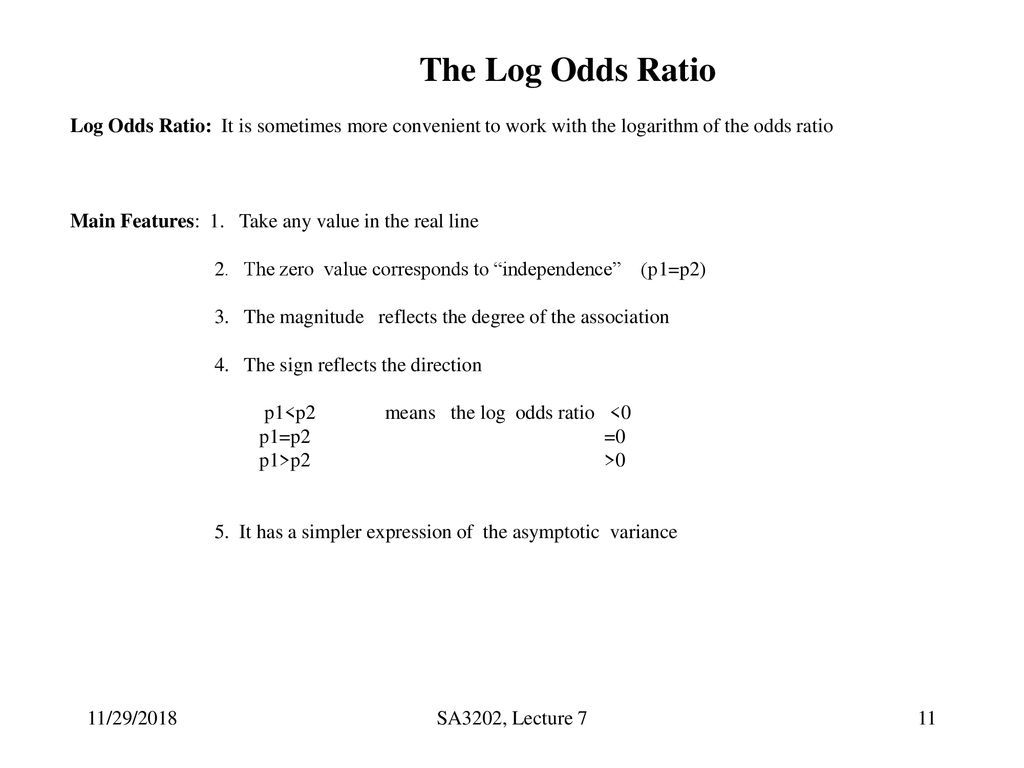



Lecture 7 The Odds Log Odds Ratios Ppt Download




Forest Plot Of Log Odds Ratios For Paresthesia Topiramate 0 Mg Vs Download Scientific Diagram




Using Ggforestplot Ggforestplot




Logistic Regression Binary Dependent Variable Pass Fail Odds Ratio P 1 P Eg 1 9 Means 1 Time In 10 Pass 9 Times Fail Log Odds Ratio Y Ln P 1 P Ppt Download




A Funnel Plot Of Log Odds Ratio Against Sample Size Download Scientific Diagram
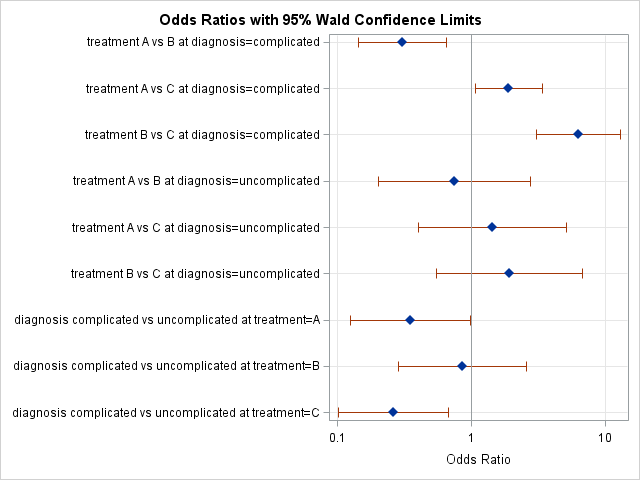



Odds Ratio Plots With A Logarithmic Scale In Sas The Do Loop




Lecture 7 The Odds Log Odds Ratios Ppt Download




Strategies For Graphing Distributions Of Log Odds Estimates And The Corresponding Odds Ratios Cross Validated
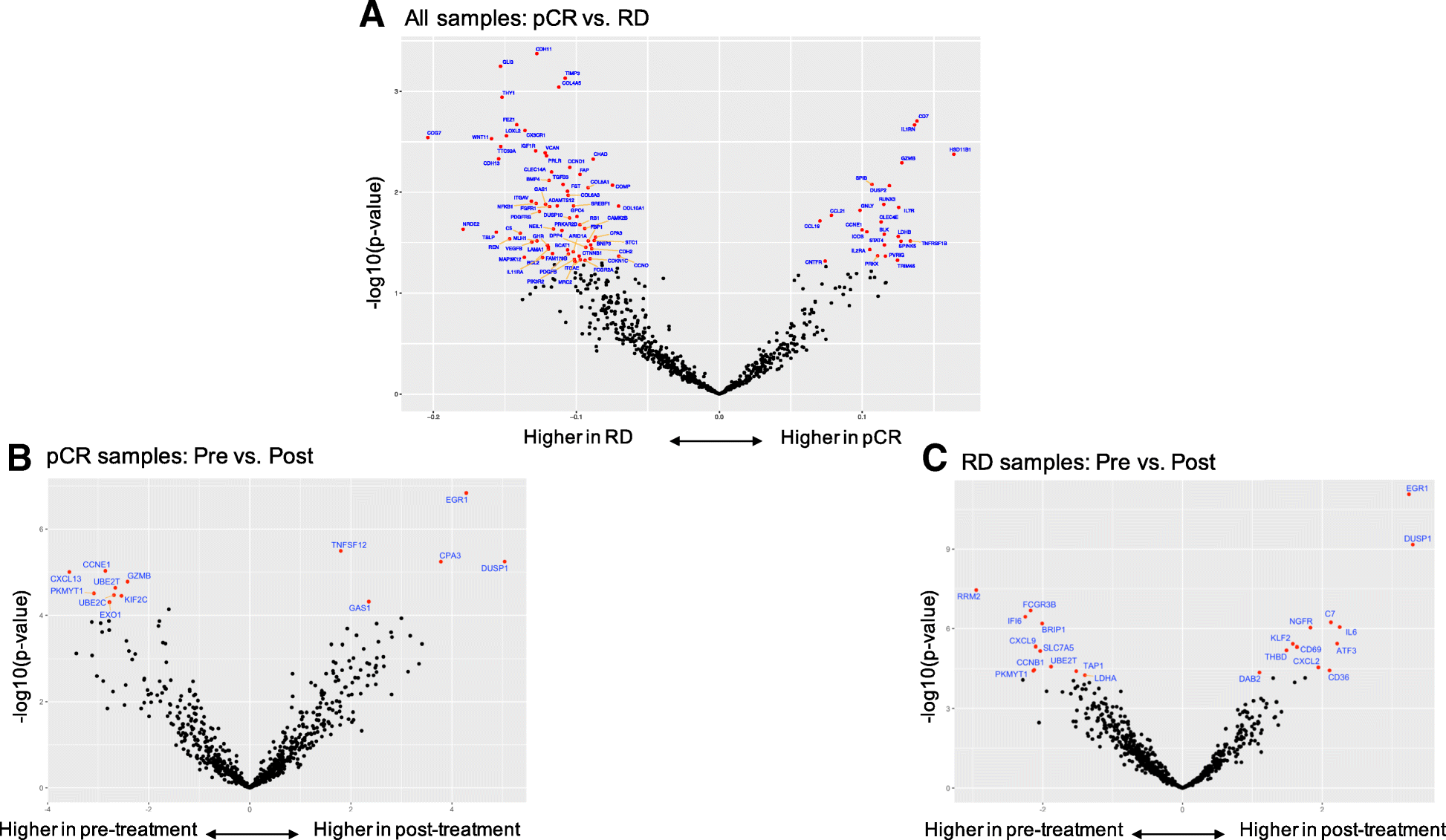



Immune Profiling Of Pre And Post Treatment Breast Cancer Tissues From The Swog S0800 Neoadjuvant Trial Journal For Immunotherapy Of Cancer Full Text
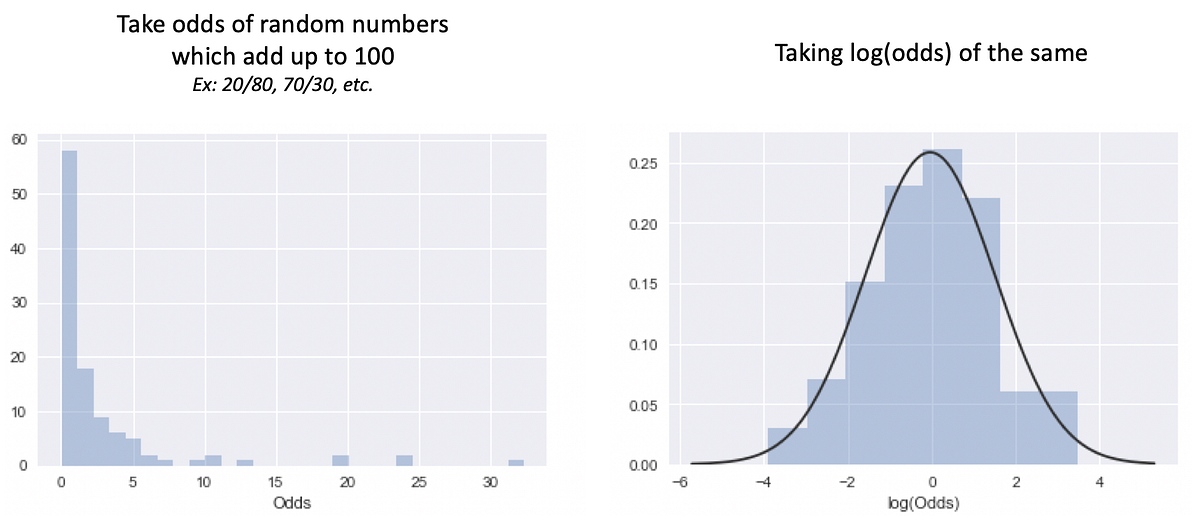



What And Why Of Log Odds What Are Log Odds And Why Are They By Piyush Agarwal Towards Data Science




Much Ado About Nothing Logit Vs Probit Stata Output Log Odds Vs Odds Ratio




Lorelograms Estimated Mean Log Odds Ratio As A Function Of Lag Time Download Scientific Diagram
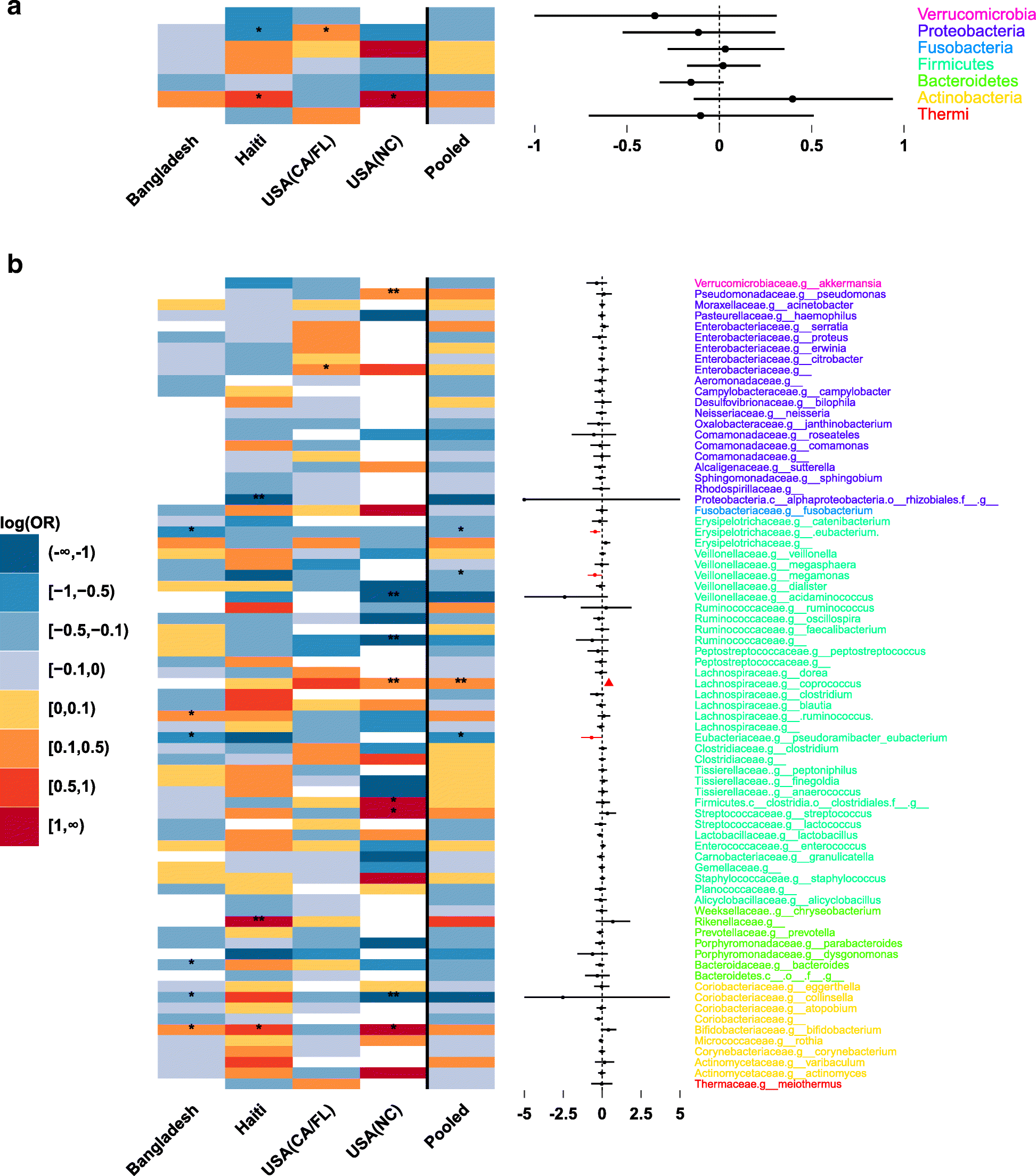



Metamicrobiomer An R Package For Analysis Of Microbiome Relative Abundance Data Using Zero Inflated Beta Gamlss And Meta Analysis Across Studies Using Random Effects Models Bmc Bioinformatics Full Text
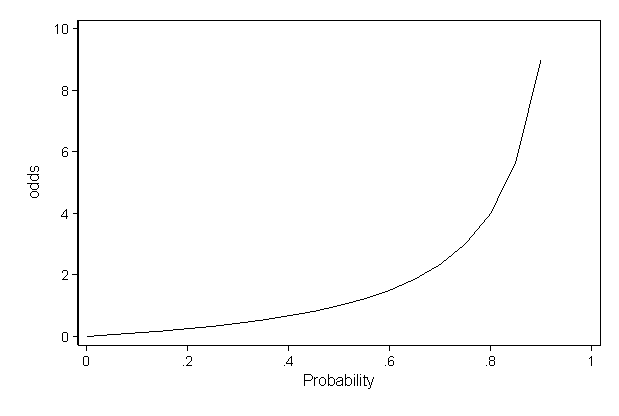



Faq How Do I Interpret Odds Ratios In Logistic Regression




Log Odds Ratio Analytics Function Series By Analyttica Datalab Medium




Odds Ratio Visualization Tidyverse Rstudio Community




Log Odds Ratio Of Adherence And 95 Confidence Interval By Site



1
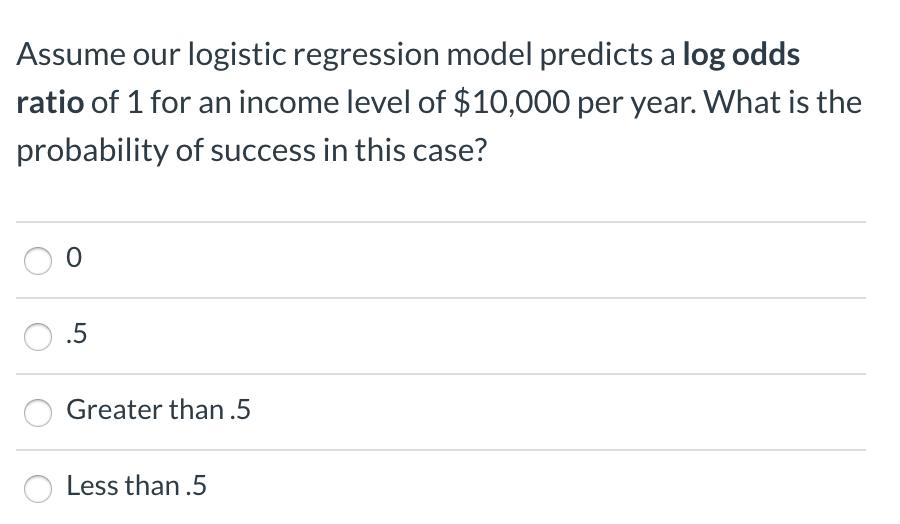



Assume Our Logistic Regression Model Predicts A Log Chegg Com




Introducing R Package Oddsratio Patrick Schratz




Into The Logistic Regression Towards Ai The Best Of Tech Science And Engineering




Odds Ratio For A Simple Distribution Jmp User Community




Distribution Of The Log Odds Ratio S In Folded Unfolded And Download Scientific Diagram



Rinterested Github Io Statistics Logistic Regression Html




Figure 5 From Identifying The Odds Ratio Estimated By A Two Stage Instrumental Variable Analysis With A Logistic Regression Model Semantic Scholar




Meta Analysis Of Odds Ratios Current Good Practices Abstract Europe Pmc
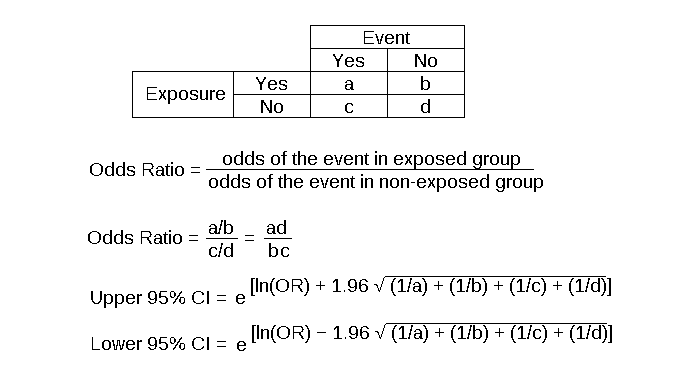



Odds Ratio Article




9 2 Binary Logistic Regression R For Health Data Science




Logistic Regression Why Sigmoid Function




For The Following Two Way Table Test The Research Chegg Com




Statistics Sunday Everyone Loves A Log Odds Ratio Deeply Trivial




Log Odds Ratio Plot Of Tnt Vs Diagnoses Download Scientific Diagram
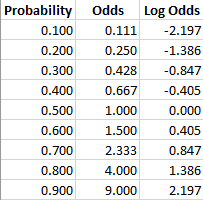



Log Odds Definition And Worked Statistics Problems



1



Http Www Floppybunny Org Robin Web Virtualclassroom Stats Statistics2 Part17 Log Reg Pdf



27 28 29 30 31 32 33 34 35 36 37 38 39 40 41 42 43 44 45 Review 1 In This Example The Equation From The Logistic Regression Model Is Written In The Form Of The Log Odds Ratio 2 As We Will See For Interpretation We Will Need To Transform Estimates




Strategies For Graphing Distributions Of Log Odds Estimates And The Corresponding Odds Ratios Modeling The Stan Forums




Diagnostic Odds Ratio Wikipedia



Logistic Regression




Statistics Sunday Everyone Loves A Log Odds Ratio Deeply Trivial
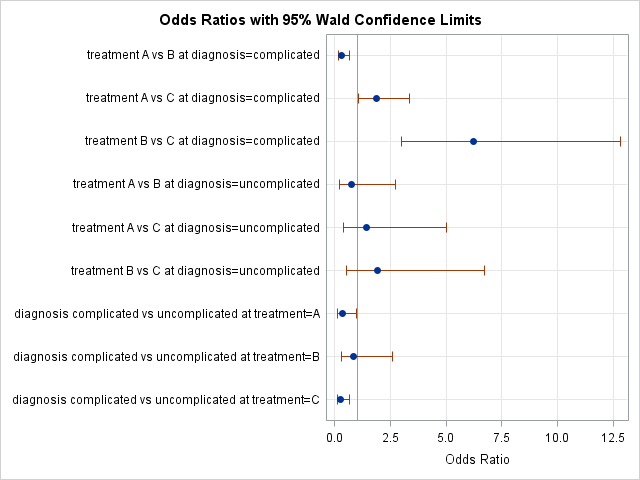



Odds Ratio Plots With A Logarithmic Scale In Sas The Do Loop




Lecture 5 Agenda Basic Contingency Table Analysis Rx
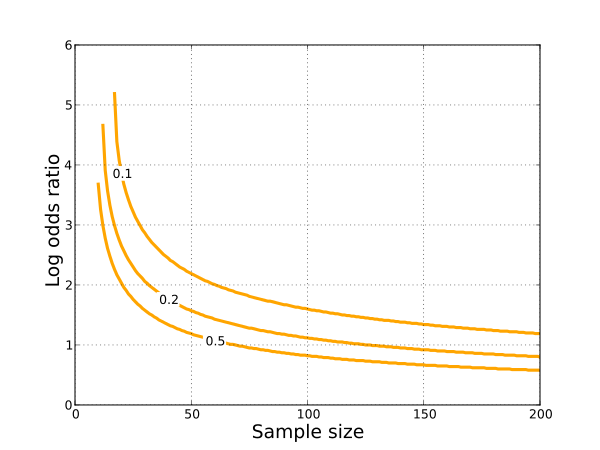



Odds Ratio Wikiwand




Statistical Analysis Sc504 Hs927 Spring Term Ppt Video Online Download




Strategies For Graphing Distributions Of Log Odds Estimates And The Corresponding Odds Ratios Modeling The Stan Forums




Odds Ratio Wikiwand



Odds Ratios Need To Be Graphed On Log Scales Andrew Wheeler




How To Get Odds Ratio In Ordinal Logistic Regression Jmp User Community



1




Relative Bias Against Log Odds Ratio For The Chapman And Chao Estimators Download Scientific Diagram
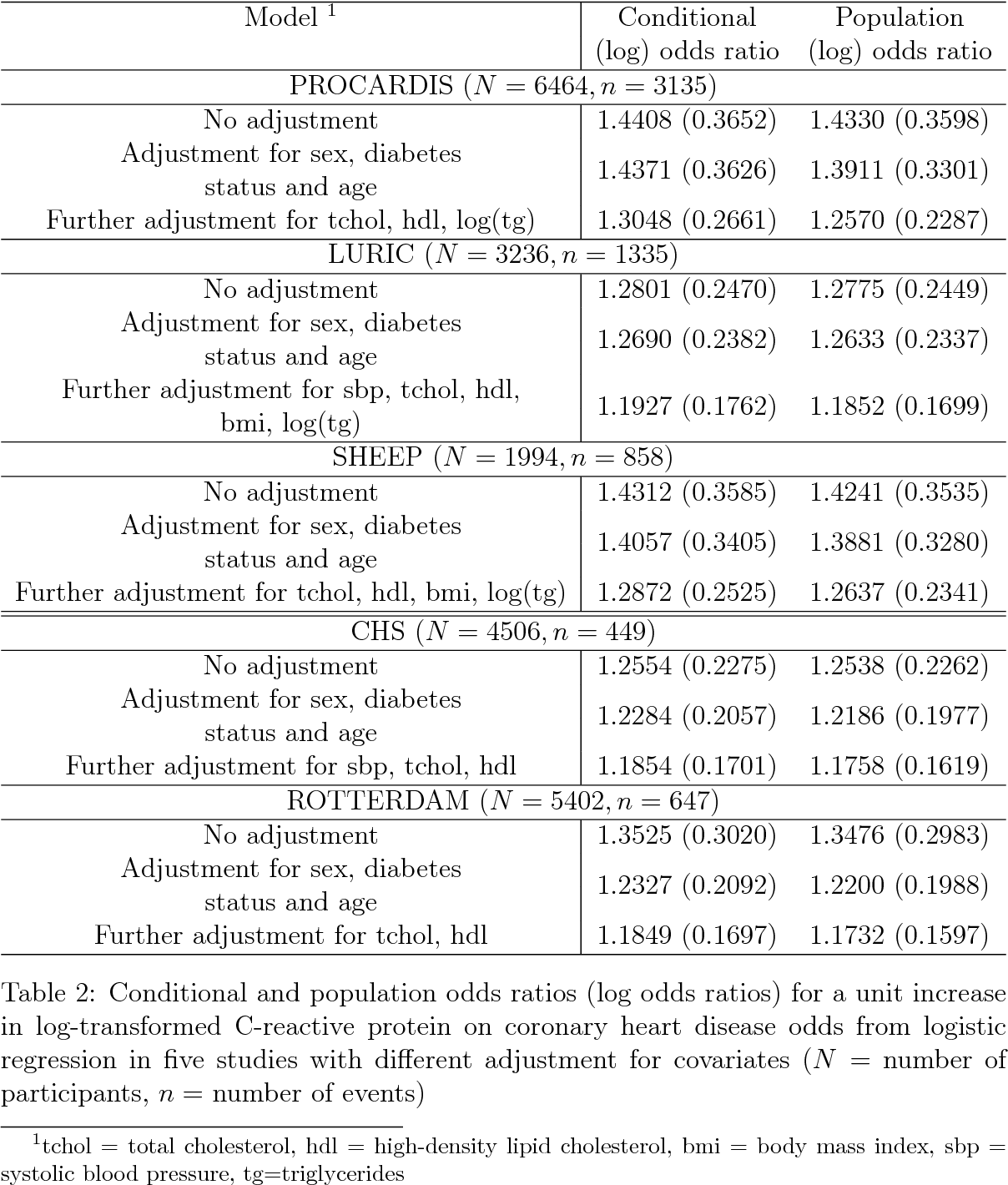



Table 2 From Identifying The Odds Ratio Estimated By A Two Stage Instrumental Variable Analysis With A Logistic Regression Model Semantic Scholar




Odds Ratio Wikipedia




Funnel Plots Comparing Log Odds Ratio Or Versus The Standard Error Of Download Scientific Diagram
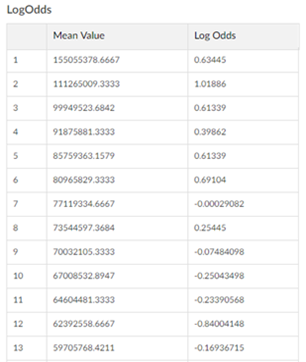



Log Odds Ratio Analytics Function Series By Analyttica Datalab Medium




Graph Tip How Can I Plot An Odds Ratio Plot Also Known As A Forest Plot Or A Meta Analysis Plot Faq 809 Graphpad



0 件のコメント:
コメントを投稿